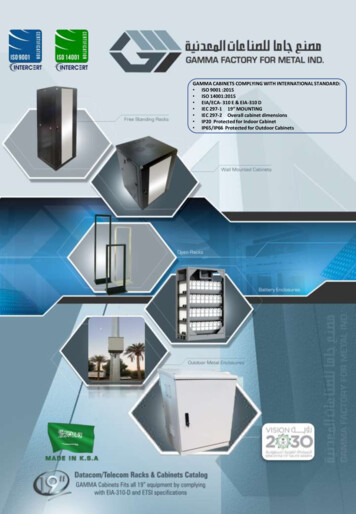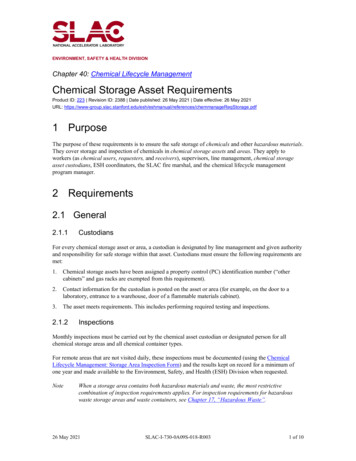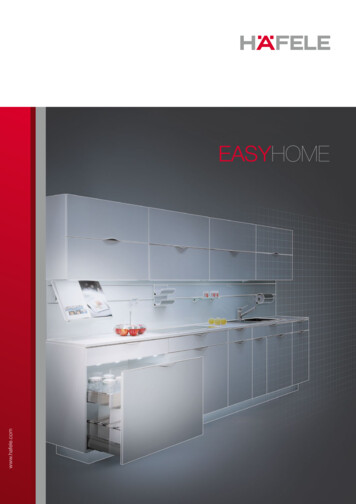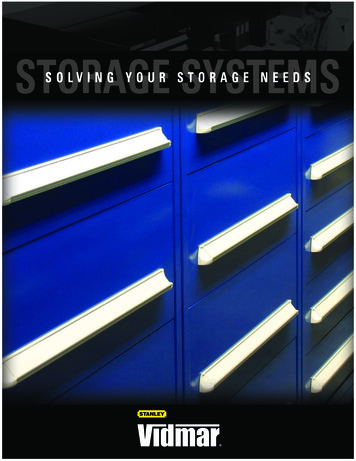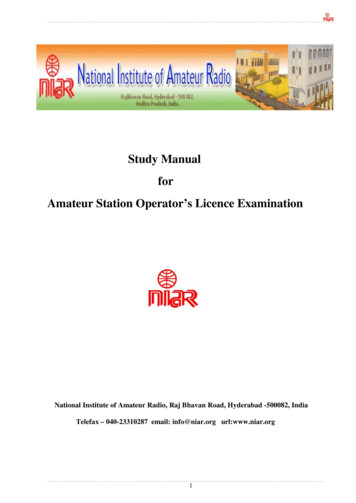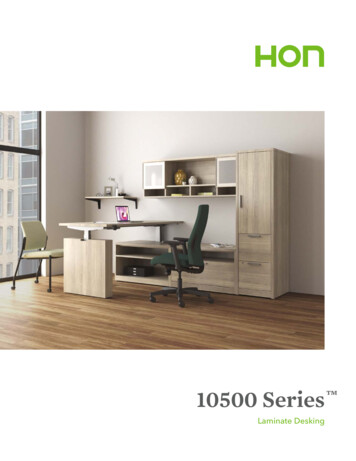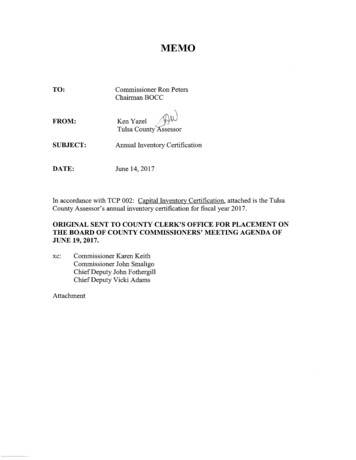
Transcription
A General Guide To Building CabinetsCopyright 2014 JaysCustomCreations.comNo materials list or cut list is included with this guide. The goal is to give you general guidance on how tobuild your own cabinets. With the diagrams in this guide you should be able figure out what materials areneeded to build the specific cabinets that you need. Also, this is not the ONLY way to build strong cabinets. It’ssimply my preferred method. All dimensions included are for reference and can be modified as needed. It’s agood idea to plan the entire cabinet before you start building it to determine how much material is needed.
Determine what size cabinets youwant to make. Kitchen cabinets aretypically taller and deeper than bathroomcabinets. The diagram on the leftrepresents the size side panels for atypical kitchen cabinet and the diagramon the right represents a typical sidepanel for a bathroom cabinet. Theseare just good starting points. Makeyour cabinets any size you want.Each cabinet needs a left and a rightpanel. While every arrow in this guiderepresents a pocket hole screw feelfree to use whatever joinery methodyou prefer. I will refer to a few partdimensions in this guide in relation toeither kitchen or bathroom cabinets.The face frame is the front structure of the cabinet consisting of rails and styles. Styles are the verticalpieces of wood and the rails are the horizontal pieces of wood. An easy way to remember this is tothink of the hand rails on a deck. These are horizontal. The two most common joinery methods for aface frame are dowels or pocket hole screws. When planning the cabinet face frame start with theoutside styles followed by the top and bottom rails. If drawers are to be included a rail spaced 4-1/2”below the top rail should be included. Any spacing for drawers is up to you. This model represents a17” drawer opening on each end and two fake drawer openings in the middle. This is where a sink willgo. The openings below are for cabinet doors that correspond to the size drawer above.jayscustomcreations.comA General Guide To Building Cabinets - Page 2
With your face frame assembled,attach the side panels to theface frame making sure the topsare flush. This can be done withpocket hole screws, biscuits, orsimply brad nailing through thefront of the face frame. Make sureyou use glue though.The rear shelf support rail andbottom shelf can be installednext. The front of the shelfshould line up with the top ofthe lower rail in the face frame.The shelf is secured to the frontface frame as well as both sidepanels. The rear shelf supportrail is secured to the shelf aswell as both side panels. I liketo use cheap 3/4” plywoodin the areas that will never beseen to reduce cost.jayscustomcreations.comA General Guide To Building Cabinets - Page 3
Add another support rail to the topback of the cabinet by securing itto the side panels. You can securethe cabinet to the wall by screwingthrough this board. Again, you canuse cheap plywood here.Connect the upper support rail in back tothe top of the face frame on at least thetwo sides. If your cabinet is shorter theinterior pieces may not be necessary. Inthis diagram they are pocket hole screwedto the face frame, side panels, and backsupport rail. You can screw through thesepieces to secure whatever countertopmaterial you choose.To dress up the bottom of the cabineta solid piece of wood can be added.This is called a toe kick. You cansecure this however you choose.jayscustomcreations.comA General Guide To Building Cabinets - Page 4
There are many ways to make drawers.Here’s the easiest method I like to use witheither 3/4” or 1/2” plywood. The side pieces(green) will be 21” long for kitchen cabinetsand 18” long for bathroom cabinets. The frontand back pieces (yellow) will be 2-1/2” lessthan your drawer opening for 3/4” plywooddrawers and 2” less than your draweropening for 1/2” plywood drawers. 3-1/2”tall is a good height for drawers when thedrawer opening on the face frame is 4-1/2”tall. Then assemble the drawers like shown,measure and cut a bottom panel from 1/4”or 3/8” plywood, and attach it directly tothe bottom of the drawer box with glue andnails if using bottom mount drawer slides. Ifusing full extension side mount drawer slidesit would be wise to use screws and glue forthe bottom panel.A few scrap wood blocks (bright red)will probably need to be secured tothe upper back rail to allow mountingof the drawer slides. With the drawerslides installed in the cabinet the drawerboxes can be put in place.jayscustomcreations.comA General Guide To Building Cabinets - Page 5
To cover up the plywood drawer box adrawer front should be added. A goodrule of thumb is to have the drawerfront, as well as doors, overlap theface frame opening by 1/2” on all sides.Clamp these in place and secure themwith screws through the front of thedrawer box. False drawer fronts canalso be added in places where a sinkprohibits the use of drawers. This will givea consistent look of drawers along thefront of your cabinet. To secure thema couple mounting blocks (bright red inlower picture) can be secured to the faceframe first. Then screw through thesemounting blocks into the fake drawerfronts.There are about as many ways tomake doors as there are ways to makedrawers. The method I used in thisdiagram is a simple tongue and groovemethod. Again, the overall size of thedoor should be 1/2” larger in all directionsthan the size opening in the face frame.Each rail and style in the door is 2-1/2”wide. A 1/2” deep groove is cut in thecenter of all the pieces that is as wide asthe plywood panel you are using. Thiscan easily be done with a table saw or arouter. Then cut matching tongues on theends of the rails. Cut a plywood panelto fit on the inside and glue the rails tothe styles. I will go into greater depth in afuture tutorial on making these doors.jayscustomcreations.comA General Guide To Building Cabinets - Page 6
Use whatever method you wantto make the doors. The simplestmethod would be to just edgeband a piece of plywood. Forshop cabinets this would be justfine. With the drawers done attachthem to the cabinet with whateverhinges you choose. Regular cabinetoverlay hinges are a good optionAdd whatever drawer and door pulls you wish to use and you’re done with the construction. Like I said,this guide was intended to provide those who haven’t made cabinets before with a good reference andfoundation to not only figure out what is needed but also build your own custom cabinets. This is justa good foundation to start with. You can most definitely get creative and add any customizations andpersonal touches to make your cabinets unique. While I provide all of my plans free of charge to youthey are not free to produce. Reaching more people is one of the ways that will help me continue toproduce more free content for you. If you found this guide useful it would be very much appreciated ifyou would share the associated website article with your friends so they might find it useful. Good luck!jayscustomcreations.comA General Guide To Building Cabinets - Page 7
jayscustomcreations.com A General Guide To Building Cabinets - Page 2 Determine what size cabinets you want to make. Kitch
